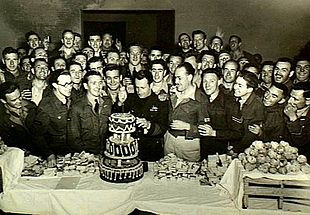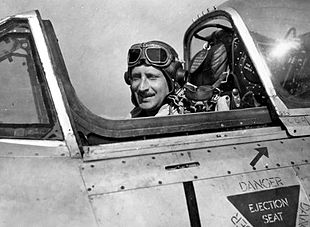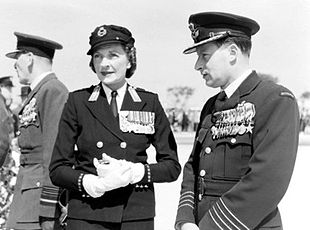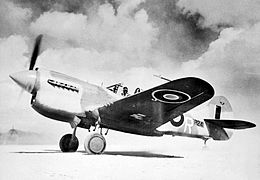Brian Eaton
Brian Alexander Eaton | |
|---|---|
No. 239 Wing RAF (1944–45) (1973)No. 81 Wing (1947–48) No. 78 Wing (1951–54) RAAF Base Williamtown (1957–59) No. 224 Group RAF (1967–68) Operational Command | |
| Battles/wars | World War II |
| Awards | Commander of the Order of the British Empire Distinguished Service Order & Bar Distinguished Flying Cross Silver Star (US) |
| Other work | Regional Executive, Rolls-Royce |
In the decade following World War II, Eaton led
Early career
Brian Eaton was born in Launceston, Tasmania, on 15 December 1916, to Sydney and Hilda Eaton.[1][2] The family later moved to Canterbury, Victoria, and Brian was educated at Carey Baptist Grammar School. His early ambition to be a doctor was curtailed when his father died and he had to leave school early.[3] He enlisted as an air cadet in the Royal Australian Air Force (RAAF) on 20 January 1936, undergoing flying training at RAAF Station Point Cook.[4] Eaton was commissioned as a pilot officer upon graduation from flying school in January 1937, and posted to No. 1 Squadron. Within six months he was promoted to flying officer and joined No. 21 Squadron at RAAF Station Laverton.[1] In 1938, he became an instructor at Point Cook's No. 1 Flying Training School, where he also took part in the RAAF's early long navigation exercises.[5][6] He was promoted to flight lieutenant on 1 September 1939.[1]
World War II
Early war service
In April 1940, Eaton was assigned to the newly re-formed
Eaton's combat career began inauspiciously, when he was shot down three times in the space of ten days. On the first occasion, his P-40 Kittyhawk was hit by 20 mm cannon shells from an enemy fighter that he never saw. He later recalled, "I was too busy getting the kite down to be frightened. But my God was I surprised." Eaton brought his crippled aircraft in for a forced landing at El Hamma—in the midst of a tank battle between German and New Zealand forces. After the fighting had died down he made his way over to the New Zealanders, who gave him a lift back to his air base. The second time he was shot down, his plane was struck by 88 mm anti-aircraft fire, necessitating another crash landing, this time behind enemy lines. Sympathetic Arab tribesmen smuggled him past the Germans and back to his airfield. Two days later, his P-40 was hit by fire from an Messerschmitt Bf 109 that dived at him from out of the sun. He was able to glide back to base, 80 miles (130 km) away, but on arriving found that it was under attack by German bombers. He decided he had no other option than to land the damaged plane among the exploding bombs, and managed to do so without mishap. His series of narrow escapes engendered a spirit of fatalism, and a habit of keeping his emotions severely in check while on duty: "I just couldn't see myself living when so many were dying. It was something which, at the time, didn't bear much dwelling on."[3][7]
Squadron and wing command

Despite his early setbacks in combat, Eaton soon rose to command No. 3 Squadron, taking over from Squadron Leader
One evening in October, 1943, this officer led his squadron in an attack on a strong enemy force, equipped with tanks, which were attacking our troops near Termoli. In spite of intense antiaircraft fire, Squadron Leader Eaton led his formation in at a low level and pressed home an attack which completely disrupted the enemy's forces. In this spirited action, Squadron Leader Eaton displayed inspiring leadership, great courage and tenacity.
On 16 February 1944, the day after the contentious destruction of Monte Cassino, Eaton took No. 3 Squadron through a break in the bad weather to attack the ruined monastery, the only one of No. 239 Wing's units to successfully bomb its target that day.[14][15] He handed over command of No. 3 Squadron later that month, and was transferred to No. 1 Mobile Operations Room Unit as forward air controller for the final assault on Monte Cassino.[1][3] The run of luck that Eaton experienced in his first weeks of air combat in Tunisia continued on the ground in Italy. He survived three months of constant artillery fire, including an occasion when a shell exploded directly above his observation post, striking down a British officer standing next to him. He also came under machine-gun fire when he took a wrong turn one day and drove into the German lines, but again escaped unhurt.[3] He was awarded the Distinguished Service Order on 7 April, in recognition of his leadership of No. 3 Squadron in North Africa, Malta, Sicily and Italy.[16][17]

Raised to acting
Eaton was unofficially credited with shooting down as many as seven enemy aircraft during the Mediterranean campaigns, but was never listed among Australian
Post-war career
Rise to senior command

Eaton was posted to Britain following the end of World War II, and attended
Returning to Australia in November 1949, Eaton became Deputy Director of Training at the Department of Air,

Completing his tour with No. 78 Wing in mid-1954, Eaton joined Air Vice-Marshal
Following his tour at Williamtown, Eaton spent two years as Director of Joint Services Plans before attending the
Senior command and retirement

Promoted to
Returning to Australia, Eaton became Air Member for Personnel (AMP) in October 1969. As AMP, he sat on the
Notes
- ^ a b c d e f g h i "Air Vice-Marshal Brian Alexander Eaton". Australian War Memorial. Retrieved 10 April 2010.
- ^ a b "Roger Leigh Eaton: Roll of Honour circular" (PDF). Australian War Memorial. Archived from the original (PDF) on 25 May 2015. Retrieved 16 April 2010.
- ^ a b c d e f g h i "'The Boss' packs it in". The Herald. 12 January 1974. p. 25.
- ^ a b "Eaton, Brian Alexander". World War 2 Nominal Roll. Retrieved 10 April 2010.
- ^ a b c d e f g Coulthard-Clark, Air Marshals of the RAAF, p. 34
- ^ Coulthard-Clark, The Third Brother, pp. 207–208
- ^ a b Mordike, The RAAF in Europe and North Africa 1939–1945, pp. 105–107
- ^ Herington, Air War Against Germany and Italy, p. 567 Archived 5 March 2016 at the Wayback Machine
- ^ a b Herington, Air Power Over Europe, p. 57 Archived 27 April 2015 at the Wayback Machine
- ^ RAAF Historical Section, Units of the Royal Australian Air Force. Volume 2: Fighter Units, p. 7
- ^ Herington, Air Power Over Europe, pp. 68–69
- ^ "Recommendation: Distinguished Flying Cross" (PDF). Australian War Memorial. Archived from the original (PDF) on 5 March 2016. Retrieved 10 April 2010.
- ^ "No. 36459". The London Gazette (Supplement). 14 December 1943. p. 1616.
- ^ Herington, Air Power Over Europe, p. 104 Archived 6 March 2016 at the Wayback Machine
- ^ Wilson, The Brotherhood of Airmen, pp. 101–102
- ^ "Recommendation: Distinguished Service Order" (PDF). Australian War Memorial. Archived from the original (PDF) on 5 March 2016. Retrieved 10 April 2010.
- ^ "No. 36459". The London Gazette (Supplement). 7 April 1944. p. 1616.
- ^ Herington, Air Power Over Europe, p. 351 Archived 27 April 2015 at the Wayback Machine
- ^ Herington, Air Power Over Europe, pp. 353–356
- ^ Scutts, Mustang Aces of the Ninth & Fifteenth Air Forces & the RAF, pp. 48–51
- ^ "Recommendation: Bar to Distinguished Service Order" (PDF). Australian War Memorial. Archived from the original (PDF) on 27 April 2015. Retrieved 10 April 2010.
- ^ "No. 37125". The London Gazette (Supplement). 12 June 1945. p. 3083.
- ^ "Recommendation: US Silver Star". Australian War Memorial. Archived from the original on 6 June 2011. Retrieved 10 April 2010.
- ^ "No. 37610". The London Gazette (Supplement). 14 June 1946. p. 3007.
- ^ Stephens, Going Solo, pp. 208–211, 214, 217, 222
- ^ Stephens, Going Solo, pp. 216–219
- ^ Wilson, The Brotherhood of Airmen, p. 144
- ^ Stephens, Going Solo, pp. 24–25
- Sunday Herald. 16 September 1951. p. 1. Retrieved 18 April 2010.
- ^ a b c Draper, Who's Who in Australia 1983, p. 275
- ^ "Jet Fighter CO weds". The Age. 12 May 1952. p. 3. Retrieved 18 April 2010.
- ^ Stephens, Going Solo, pp. 202–203
- ^ "They're off to the Middle East: brides going, too—on honeymoon". The Sunday Herald. 29 June 1952. p. 5. Retrieved 18 April 2010.
- ^ Newton, Clash of Eagles, p. 111
- ^ "Promotions in RAAF". The Canberra Times. 1 January 1953. p. 2. Retrieved 18 April 2010.
- ^ Stephens, Going Solo, p. 206
- ^ Stephens, Going Solo, pp. 38–39
- ^ Stephens, Power Plus Attitude, pp. 142, 160
- ^ Stephens, Going Solo, p. 354
- ^ Stephens, Going Solo, pp. 416–18
- ^ Stephens, Going Solo, pp. 160–161
- ^ RAAF Historical Section, Units of the Royal Australian Air Force: Bases, p. 171
- ^ "No. 41728". The London Gazette (Supplement). 13 June 1959. p. 3736.
- ^ Stephens, Going Solo, pp. 317–322
- ^ Stephens, The Royal Australian Air Force, p. 298
- ^ Stephens, Going Solo, pp. 161–163
- ^ Stephens, Power Plus Attitude, pp. 124, 132
- ^ Coulthard-Clark, The RAAF in Vietnam, pp. 90–91
- ^ Stephens, Going Solo, p. 255
- ^ "No. 44864". The London Gazette (Supplement). 14 June 1969. p. 5995.
- ^ a b Stephens, Going Solo, p. 500
- ^ Stephens, The Royal Australian Air Force, p. 112
- ^ Stephens, The Royal Australian Air Force, p. 290
- ^ "Air Vice-Marshal B.A. Eaton Award (Airman of the year)". Royal Australian Air Force. Retrieved 16 April 2010.
References
- Coulthard-Clark, Chris (1995). Air Marshals of the RAAF 1935–1995. Canberra: Department of Defence (Air Force Office).
- Coulthard-Clark, Chris (1991). The Third Brother. North Sydney: ISBN 0-04-442307-1.
- Coulthard-Clark, Chris (1995). The RAAF in Vietnam: Australian Air Involvement in the Vietnam War 1962–1975. St Leonards, New South Wales: Allen & Unwin in association with the ISBN 1-86373-305-1.
- Draper, W.J., ed. (1983). Who's Who in Australia 1983. Melbourne.
{{cite book}}:|work=ignored (help)CS1 maint: location missing publisher (link) - Herington, John (1963). Australia in the War of 1939–1945: Series Three (Air) Volume IV – Air Power Over Europe 1944–1945. Canberra: Australian War Memorial. OCLC 3633419. Archived from the originalon 14 March 2011.
- Herington, John (1954). Australia in the War of 1939–1945: Series Three (Air) Volume III – Air War Against Germany and Italy 1939–1943. Canberra: Australian War Memorial. OCLC 3633363. Archived from the originalon 4 April 2012.
- Newton, Dennis (1996). Clash of Eagles. Kenthurst, New South Wales: Kangaroo Press. ISBN 0-86417-793-3.
- RAAF Historical Section (1995). Units of the Royal Australian Air Force: A Concise History. Volume 1: Introduction, Bases, Supporting Organisations. Canberra: ISBN 0-644-42792-2.
- RAAF Historical Section (1995). Units of the Royal Australian Air Force: A Concise History. Volume 2: Fighter Units. Canberra: Australian Government Publishing Service. ISBN 0-644-42794-9.
- Schubert, David (20 October 1994). John Mordike (ed.). RAAF personalities in the European and North African Campaigns during World War II. The RAAF in Europe and North Africa 1939–1945: The Proceedings of the 1994 RAAF History Conference. Canberra, Australian Capital Territory: RAAF Air Power Studies Centre. ISBN 0-642-22475-7. Archived from the originalon 28 February 2011.
- Scutts, Jerry (1995). Mustang Aces of the Ninth & Fifteenth Air Forces & the RAF. Oxford: ISBN 1-85532-583-7.
- Stephens, Alan (1995). Going Solo: The Royal Australian Air Force 1946–1971. Canberra: Australian Government Publishing Service. ISBN 0-644-42803-1.
- Stephens, Alan (1992). Power Plus Attitude: Ideas, Strategy and Doctrine in the Royal Australian Air Force 1921–1991. Canberra: Australian Government Publishing Service. ISBN 0-644-24388-0.
- Stephens, Alan (2006) [2001]. The Royal Australian Air Force: A History. London: ISBN 0-19-555541-4.
- Wilson, David (2005). The Brotherhood of Airmen. Crows Nest, New South Wales: Allen & Unwin. ISBN 1-74114-333-0.

